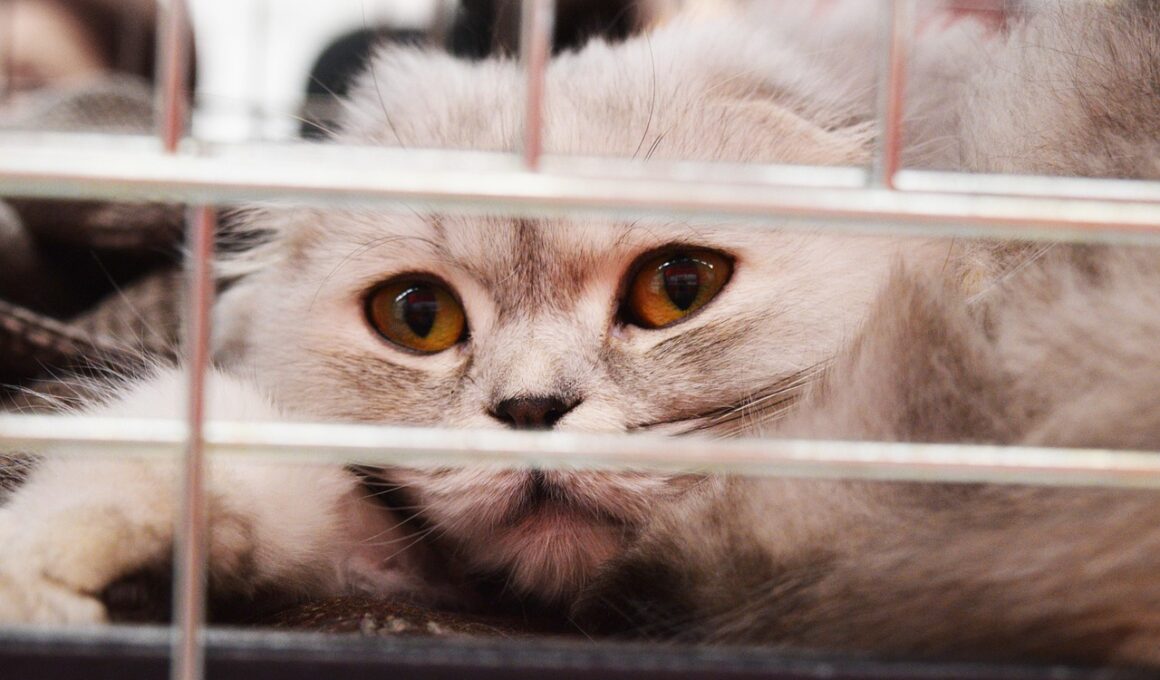Common Mistakes to Avoid When Socializing Your Adopted Cat
When you bring an adopted cat into your home, the initial step in the socialization process is crucial. A major mistake many people make is overwhelming the cat too quickly. Allow your new pet to explore its surroundings at its own pace. Provide a safe, quiet space where the cat can retreat and feel comfortable. Remember, patience is important during this transition period. Also, avoid forcing interactions with family members or other pets. Instead, let the cat approach them when it feels secure. Over time, gradual exposure will build its confidence, helping it to feel more at ease in your home. Additionally, monitor the cat’s body language; signs of stress should be taken seriously. If your cat seems anxious or fearful, reconsider your approach and give it more time. Furthermore, neglecting to establish a consistent daily routine can create unnecessary stress for your new feline friend. Cats thrive on predictability, so try to maintain a regular feeding and playtime schedule. By understanding these key concepts, you’ll create a more welcoming environment for your adopted cat.
Another common pitfall when socializing your newly adopted cat is neglecting the importance of gradual introductions. Rapid introductions to new environments, sounds, and people can lead to overwhelming stress for your cat. Instead, introduce one new element at a time, allowing your cat to adapt without pressure. This includes not just people but also other pets in the household. Each interaction should be carefully monitored to ensure a safe and comfortable environment. When introducing pets, supervise all interactions and provide separate spaces where each animal can retreat to feel secure if they need to. Furthermore, never rush the process; let your cat signal when it’s ready to engage. In addition, emotional support during this time is essential. Use soft voices, gentle petting, and engaging toys to create positive associations. Ensure your home is a calm refuge with minimal loud noises and sudden movements. Lastly, do not underestimate the power of play. Interactive playtime helps strengthen your bond and encourages the cat to feel more at home. Engaging in regular, fun activities not only builds trust but also enhances your cat’s confidence.
Understanding your cat’s unique personality is vital in the socialization process, and overlooking this can lead to setbacks. Every cat has its own temperament; some may possess a laid-back attitude, while others are naturally shy or anxious. Ignoring individual traits often causes frustration. Take the time to observe and learn the specific preferences of your adopted cat. Recognize when it prefers solitude or needs affection, and tailor your approach accordingly. Being attentive to these cues promotes trust and an overall positive relationship. Moreover, another error is failing to provide mental stimulation and environmental enrichment. Cats are intelligent beings that thrive on interaction and exploration. Boredom can lead to behavioral issues, making the socialization effort more challenging. Consider integrating scratching posts, climbing trees, and interactive toys into your cat’s daily life. Rotate toys to maintain their interest, and engage in varied types of play. Equally important is establishing a consistent feeding environment. Cats appreciate a stable routine, which helps them feel secure. Following these guidelines can significantly ease the transition from shelter life to a loving home, ensuring a happy and well-adjusted feline companion.
Consistency and Positive Reinforcement
Consistency is key in the socialization process, yet some individuals forget its importance. Inconsistency can confuse your adopted cat and delay its adjustment to a new home. Ensure family members know the rules for interactions and routines. Everyone should be on the same page concerning feeding times, play schedules, and handling methods. By maintaining a collective approach, your cat will feel more secure and confident. Furthermore, employing positive reinforcement techniques is a common practice that can also be misapplied. Using treats or praise can greatly encourage desired behaviors, but timing is essential. For the best results, reward your cat immediately after a positive behavior is displayed. This helps create a clear association between the action and the reward. However, avoid over-relying on treats, as this can lead to obesity or other health issues. Balance treats with verbal praise and affection. Also, never punish your cat for unwanted behavior; this can create fear and hinder progress. Instead, focus on redirecting negative actions to positive alternatives. Understanding how to use these methods properly will greatly enhance your ability to socialize your adopted cat effectively.
Another frequent mistake in the socialization journey is neglecting to create a safe, enriching environment for your cat. Without proper stimulation, your cat may feel bored or anxious, undermining its adjustment period. To enhance its living space, invest in cat trees, toys, and cozy hiding spots. Cats naturally love to explore and climb, and providing multiple vertical spaces encourages physical activity. Additionally, incorporating scratching posts can help satisfy their instinctual behaviors. Engage your new pet by changing the layout occasionally, introducing new toys or challenges. Moreover, outdoor access also provides enriching experiences, allowing your cat to safely explore the outdoors. However, always supervise outdoor time to ensure safety. If you live in an area with potential dangers, such as busy roads or aggressive wildlife, consider building a secure catio or utilizing leash training. Throughout this process, remember the significance of routine. Establishing feeding and play schedules helps your cat feel stable. Consistency will solidify its understanding of what to expect daily. By creating an enriched and secure environment, you will foster a positive transition for your newly adopted feline friend.
Regular Health Check-ups
One of the often-overlooked aspects of socialization is your cat’s health. Ignoring potential health problems can lead to behavioral issues stemming from pain or discomfort. Regular veterinary check-ups are essential, especially during the adaptation phase. Some cats may be hesitant to socialize due to underlying dental, gastrointestinal, or even neurological problems. It is crucial to schedule an initial vet visit shortly after adopting your cat. Speak to your veterinarian about concerns related to behavior, diet, and other potential health issues that could influence the socialization journey. Moreover, keep updated with vaccinations and parasite prevention to ensure your cat’s well-being. A healthy cat is more likely to be open to socializing, as it feels energetic and pain-free. If health concerns arise, addressing them promptly can significantly impact your cat’s willingness to engage with its environment and family members. Also, take time to familiarize your new cat with its carrier, making future vet visits less stressful. A comfortable carrier and positive reinforcement during the journey can significantly ease travel anxiety. In conclusion, prioritize health checks as a vital part of the socialization equation.
A final common mistake in socializing your adopted cat is overlooking the importance of patience. Transitioning into a new home can take days, weeks, or even months. Rushing the process often results in setbacks, and your cat may need more time than anticipated to adjust fully. Allow your cat to acclimate to its environment and new family members gradually. Create a personal space for your cat where it can retreat if feeling overwhelmed. Avoid pushing it into situations that elicit anxiety. Instead, watch for its readiness to interact more with you and other pets. Respecting its pace fosters trust and security, enabling a smoother socialization experience. Additionally, celebrate small victories along the way; acknowledge any progress your cat makes, regardless of how minor. Offer praise or treats when your cat demonstrates bravery or curiosity. By recognizing these achievements, you create a positive reinforcement loop that encourages more of the desired behavior. Finally, educate yourself continually about cat behavior as this knowledge can empower your efforts in socialization. A well-informed pet owner is an invaluable ally to their adopted cat during this important adjustment period.


